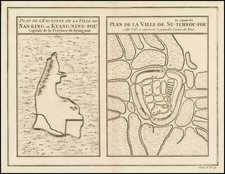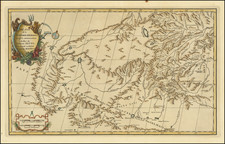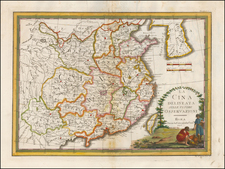The Earliest Known Map of China.
Extremely rare and early example of the emblematic Dili Tu (墬理圖) [Geographic Map of China] stone map, originally made in circa 1190 by the Chinese polymath Huang Shang (黃裳). The map is a traditional Chinese stone rubbing taken from a stone stelae map. Radiocarbon dating has placed the production of this map between 1493 and 1602, thus making it the earliest-known rubbing of a map of China. It is also one of the earliest surviving cartographic materials made in all of China in the Common Era.
The Dili tu shows China in exacting detail. The original map was presented to the Song Emperor in 1194. Unfortunately, the original map of China did not survive. However, a half-century later, in 1247, Wang Zhiyuan (王致遠) engraved a copy of the Huang Shang map of 1190 on stone stelae. The present example is the oldest-known surviving rubbing taken from the Wang Zhuiyuan stone and one of only a few to survive. Rubbings taken from these stelae are of superlative rarity particularly outside of Asia, and are seldom seen on the market. A rubbing made this early is an unparalleled cartographic object of the utmost scarcity.
The Dili tu map
In this map, China is laid out on the top two-thirds of the rubbing, with hundreds of settlements shown in oval and rectangle cartouches. Mountains, hills, and forests are elegantly added in among the characters, with China’s many rivers flowing throughout.
The Great Wall to the north is marked with a double line. In this map, the Yellow River flows from Jishi Mountain. Other maps feature the Kunlun Mountain as the Yellow River source. Here, Kunlun Mountain is pushed far away to the west, as far as possible from the core imperial territories.
The bottom third of the rubbing is filled with notes describing not only the geography, but also the history of China. It is standard in Chinese mapmaking to pair graphic depiction with expository text. Here, the text at the bottom links time and space, describing the history of China beginning from the founding narrative of Yu the Great who tamed the rivers and land. The thrust of the narrative discusses the perennial fragmentation and reunification of the empire.
Some of the characteristics of the map suggest that it derives from an earlier source map. The cartographic principles involved are in the Huayi tu tradition [Map of China and the Barbarians, 1137]. The mountains and forests are naturalistically drawn in, there is no grid system, and the place-names are inserted in cartouches. The coastline and the Shandong peninsula are, however, better represented than in the 1137 map. One of the many scholars who has studied this map, Aoyama, considers that in all its essentials, the contents and style of the Dili tu date to Shen Kuo’s time, a century earlier than the initial creation date of ca. 1190.
The three characters at the top suggest a transliteration of zhuili. However, the title is more properly "Dili tu 墬理圖". This literally means "diagram of terrestrial organization" or, more simply, "map of geography". This differentiates this map from maps of astronomy or cosmography. The zhui 墜 (to fall) is a variant for di 墬, which is itself an ancient variant for di 地 (earth). Dili 地理, or in this case dili 墬理, means "terrestrial organization" or simply "geography". Some scholars in China thus refer to this map as the 地理圖 (地理图 in simplified characters).
Creation, Preservation, and Subsequent Rubbings made in China
The cartographer, geographer, astronomer, and imperial tutor Huang Shang produced between four (Cao 1958) and eight (Needham 1979) maps in 1190 (Cao) or 1193 (Needham), which were presented to Emperor Guangzong of the Song 宋光宗 in 1194. These include an astronomical star chart (Tianwen tu), a diagram of the quasi-mythical imperial lineage (Diwang shaoyun tu), and a map of the Chinese empire (Dili tu). It is unclear whether a city map of present-day Suzhou (Pingjiang tu) was also produced by Huang.
These four documents were carved onto stone stelae in the first half of the thirteenth century, with both the Dili tu and the Tianwen tu carved in 1247 by Wang Zhiyuan. All four of the stone documents of Huang Shang are still extant and preserved, albeit with varying degrees of damage. The Dili tu is at the Museum of Engraved Stone Tablets in the Confucian Temple in Suzhou (Suzhou wenmiao 苏州文庙). The Tianwen tu is at the Purple Mountain Observatory.
These four items constitute the bulk of the earliest extant conventionally-recognized Chinese maps from the Common Era (there are a handful of extant maps from before the Common Era, but relative silence for the first millennium CE). The other two key maps from this period are the aforementioned Huayi tu and the Yuji tu, each carved onto one side of the same stele in 1136. They are preserved today in the Forest of Stone Stelae Museum in Xi'an.
Mapping in China
Mapping has a long history in China, where they were used for administration, illustration, and education. They depicted physical space, but also could be used to show the connection between earth and heaven; maps could be cosmological tools as well as political tools.
Until the end of the Qing dynasty, no specialized group existed for mapmaking. Instead, mapmakers tended to be government officials or scholars, but there was no formal training in cartography per se. This meant that surviving maps are of varying quality and detail, depending on the maker, purpose and intended audience for the work.
Many Chinese maps are concerned not only with geography, but with history. This is true of the Dili Tu. As Yee points out, it shows the capitals of the Northern Song (960-1126) and Liao dynasties, both of which had been lost to the Jin. Elsewhere, a note mentions Guangwudi (r. 25-57), restorer of the Han dynasty (206 BC-220 CE). By referencing recent losses and previous rulers, the map was intended to teach a new ruler the extent of his lands, the possible expansion he could undertake, and the stakes of following in august footsteps like those of Guangwudi.
The earliest extant “world-maps” in China date from the Song dynasty (960-1279), precisely the period when these items were drawn. Another example is the Gujin Huayi quyu zongyao tu [General Map of Chinese and Barbarian Territories, Past and Present], which dates to ca. 1130. More famous is the Huayi tu [Map of China and the Barbarians; 1136], to which the Dili Tu seems to be connected.
The Song Dynasty
This stone map was made during the Song Dynasty, an influential period in Chinese history. Lasting from 960 to 1279, the Song Dynasty ruled when Marco Polo visited China. The stories he brought back impressed European readers and filled their imaginations for several centuries. Many of the things that so impressed Polo, and which became features which Westerners associated with Chinese culture, were adopted during the Song Dynasty. These include the widespread drinking of tea, the adoption of a rice-based diet, the distinctive curved-up corners of roofs, and, less positively, the binding of women’s feet (now outlawed). China was the most technologically-advanced society in the world at the time, with particular innovations in iron-working, printing, and agriculture.
Founded by Zhao Kuangyin, the Song Dynasty came to power via a coup d’état in 960. Zhao Kuangyin was a military inspector, which gave him the powerful position necessary to take over the government. Zhao, known as Emperor Taizu, consolidated power, strengthened the civil service, and honed the skills of the empire’s elite military units, all of which helped him to expand the empire southward.
His successors maintained the large empire Taizu had created, but the bureaucracy weakened over time. In the twelfth century, the Jin managed to wrestle nearly half of the Song’s territory from them, although the Jin were stopped at the Yangtze River. From 1127, the Southern Song Dynasty continued to rule, led first by the Emperor Gaozong. He again strengthened the civil service.
This map was made as teaching aid for a young prince who was to become the Emperor Ningzong (r. 1195-1224). During his reign, Ningzong again tried to expand north and reclaim the lands held during the Northern Song, but he was pushed back.
Outside forces continued to interfere. The Mongols, led by Genghis Khan, attacked the Jin to the north in 1211. After decades of uneasy peace, the Mongols, now led by Khan’s grandsons, then attacked the lands of the Southern Song. The capital, Lin’an (Hangzhou), fell in 1276 and the dynasty failed in 1279.
At the time the map stones were made, there were several cities with populations over 1,000,000 in China. The Song Dynasty oversaw a large increase in the population of China, as well as the spread of the use of paper money, the creation and expansion of a welfare state, the adoption of moveable type, and the organization of trade guilds. It was a time of prosperity for China and these documents are but one example of that economic and intellectual success.
Rarity and carbon dating
Although the original map is no longer extant, the 1247 stone stele is. It is kept in the Museum of Engraved Stone Tablets at the Suzhou Confucian Temple (Dili tu).
Rubbings of this quality are very rare, as the Chinese government closely regulates how many can be made. Additionally, most extant rubbings are held in institutions within China, making this one of the few examples outside of Asia. The majority of the other extant rubbings were made in the nineteenth and twentieth centuries.
To establish the date of this rubbing, the paper fibers of the map underwent radiocarbon dating and the ink underwent pigment analysis. The conclusion of Art Analysis & Research is summarized in the following paragraph:
Radiocarbon dating analysis was performed on a sample of the paper support taken from a rubbing of a twelfth century Dili Tu Map of the Chinese Empire known as Terrestrial. This analysis indicated two possible date ranges of the paper fibers, 1493-1602 and 1615-1645, with the greater probability believed to be 1493-1602. Thus, the earliest possible date of the paper support is very late 15th century.
The full radiocarbon dating report is available upon request.
This map is owned jointly by Barry Lawrence Ruderman Antique Maps and Geographicus Rare Antique Maps.













![La Tartaria Chinese . . . 1784 [show Corea]](https://storage.googleapis.com/raremaps/img/small/97766.jpg)
![[ Battle of Shanghai - Third Shanghai Expeditionary Force ] Shanghai and District 1936 Edition](https://storage.googleapis.com/raremaps/img/small/100559.jpg)
![(Southwestern China) Iunan, Queicheu, e Quangsi Provincie della China. . . [Yunnan, Guizhou, and Guangxi Provinces of China]](https://storage.googleapis.com/raremaps/img/small/70078mp2.jpg)
